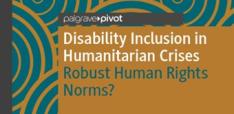Building Resilient Environments at all Levels

It is clear that the New Urban Agenda (NUA) sets ambitious goals regarding environmental sustainability and resilience, acknowledging them as crucial elements in order to achieve the Sustainable Development Goals (SDG) for all. Even though the concept of ‘resilience’ has been consistently mentioned through the commitments of the NUA, the greater challenge here is its implementation at all levels.
By day four of the Habitat III conference I have had the opportunity to attend different events focused on climate change, resilient cities and urban ecology. Urban resilience is a concept which is commonly associated with risk prevention of natural disasters, such as tsunamis, earthquakes and floods. Although most of the side events on resilience at Habitat III focused on disaster risk reduction, the NUA provides us with a broader and more complex understanding of the term ‘resilience’. The text on the NUA invites us to think about it as an inclusive concept that involves not only climate adaptation or disaster response but also socio-cultural shocks, like violence, insecurity, discrimination and gender inequality, as well as environmental and economic stresses.
The issues cities are facing nowadays are very similar to what they faced twenty years ago, when Habitat II took place in 1996. So the question that has been running through my mind these past days is: if it is has been so hard to address these challenges over the last 20 years, what can now be done to successfully implement the resilience strategies established in the NUA?
We can agree on the fact that these strategies depend on the specific needs of the broader context in which the city is located. The strategies used in Indonesia when the tsunami struck, for example, cannot be used the same way in Medellín, which faced tremendous violence issues related to drug cartel in the 90s. Every city has different environments, economies and policies. In this sense, the socio-cultural background of a city is key in the sustainable development plan. Without social inclusion there is no community, and community is the heart of the city. A lot has been said about how people’s participation with local authorities and private sector is key in building resilience. This is especially the case at low income levels, as the inhabitants know better than anyone their needs, and those strategies impact directly in their social condition.
Today, 60% of land on Earth has not yet been developed, which opens a huge window of opportunity to urban practitioners to apply resilient strategies in long term sustainable planning. Comparing the experiences shared by mayors and NGOs at the different roundtables and dialogues of Habitat III, we can set a toolbox of resilience strategies that actually make the implementation of the NUA (which some may say is a bit utopian) possible in the short term.
First, we need strong and healthy communities that are provided with clean, potable water, where food is produced locally. Local policies need to be created around the NUA goals to reduce urban poor communities’ vulnerability to risk. Resilience strategies create a protection framework for those communities by giving them a voice and involving them in the decision making process.
Mexico City has been putting all its efforts in taking action to reduce air pollution and biodiversity degradation, specifically in three regards: equitable access to public space and amenities for all, mobility model that prioritizes safe public transportation, water access and flood prevention as well as building capacity to respond to natural or social stresses.
In order to face the challenges of tomorrow we need to understand that cities are ecological – as the Senior Minister of State of Singapore Desmond Lee put it, “a livable city needs to have green in its DNA”. Local and national governments have emphasized the importance of community engagement in the process of building a city, including ecology education from pre-school levels. I reacted to this with the question: what about flora and fauna, how do they participate and how is their “voice” heard? Nature is a living system on which cities rely, the one cannot exist without the other. It is very active in the process as it reacts to the human activities.
Not only does green infrastructure help to purify the air reducing CO2 emissions, but it also makes a city more visually attractive providing inclusive spaces where people, flora and fauna coexist; preserving natural landscape is crucial to reduce risk of disaster and improve quality of life. Paying attention to ecology is also essential for resilience over time: “We can’t design single strategies, we need to think the longer term” said Santiago Uribe Rocha, Chief Resilience Officer of Medellín at one of the sessions on resilience at Habitat III.
Now that the NUA has been approved, the challenge will be for local authorities to commit to collaborate with national governments and the private sector to invest in urban resilience, otherwise this noble goal will not come to reality.
Jose Roberto Lagunes Trejo (@joseR_lt) is studying for a Master’s in Urban Design. His interests at the conference are related to urban inequalities, inclusive cities and urban ecology. He will be covering the New Urban Agenda’s approach to issues of urban sustainability and resilience specifically in the face of climate change. To keep up to date with the GLI team’s commentaries and policy pieces from HABITAT III, or for outputs by GLI teams at other international events please see here.


